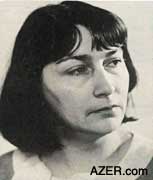

 字體:小 中 大
字體:小 中 大 |
|
|
|
| 2011/10/15 20:43:29瀏覽797|回應0|推薦0 | |
Stevenson (以DSCH作曲) - Passacaglia on DSCH (Part 1/3)The first movement opens with the DSCH motif which was Shostakovich's musical signature. This slow, extremely sad theme can also be heard in his Cello Concerto No. 1, Symphony No. 10, Violin Concerto No. 1, Symphony No. 15, and Piano Sonata No. 2. The motif is used in every movement of this quartet, and is the basis of the faster theme of the third movement. Shostakovich - Piano Sonata No. 2 (Emil Gilels) Cello Concerto No. 1 (Shostakovich) The first movement begins with its four-note main theme derived from the composer's DSCH motif, although the intervals, rhythm and shape of the motto are continually distorted and re-shaped throughout the movement. Shostakovich - String Quartet No. 8 - 1st Mvt. The first movement opens with the DSCH motif which was Shostakovich's musical signature. Violin Concerto No. 1 (Shostakovich) the second movement Scherzo as "demoniac". The Scherzo is also notable for an appearance by the DSCH motif -- a motif that reoccurs in many of the composer's works representing Shostakovich himself. Shostakovich : Symphony No. 10 More recently Nelly Kravetz, published an article that shed light on the part that “no one has yet guessed [is about]” namely the third movement. Azerbaijani pianist and composer Elmira Nazirova, had studied with Shostakovich in 1947. During the composition of the Symphony No. 10 Shostakovich engaged in a detailed personal correspondence with Elmira who served as his muse rather than mistress during this trying time for him. Using both note letter names and solfeggio syllables Shostakovich turned “Elmira” into the mysterious horn motif.  Example 5. Motifs based on names At concert pitch one fifth lower, the notes spell out "E La Mi Re A" in a combination of French and German notation. This motif, called out twelve times on the horn, represents Elmira Nazirova, a student of the composer's with whom he fell in love. The motif is of ambiguous tonality, giving it an air of uncertainty or hollowness.[2] In a letter to Nazirova, Shostakovich himself noted the similarity of the motif to the ape call in the first movement of Das Lied von der Erde, a work which he had been listening to around that time:[3] ( The same notes are used in both motifs, and both are repeatedly played by the horn.  Symphony No. 15 (Shostakovich) Deceptively, the composer likened the first movement to 'a toy shop',[citation needed] referring to a superficial sense of child-like innocence and naivete which is soon corrupted. The movement opens with two chimes on the glockenspiel, and a lengthy passage for the solo flute, growing out of a quirky five-note motif which flits between A♭ major and A minor (connected by a C♮), accompanied by slow-changing but lively chords for pizzicato strings. A♭ being As in German notation, these five notes, E♭-A♭-C-B-A, spell out the name "SASCHA", the name of his grandson who was nine years old at the time (compare this to the "Elmira" theme in Symphony No. 10). |
|
| ( 不分類|不分類 ) |











